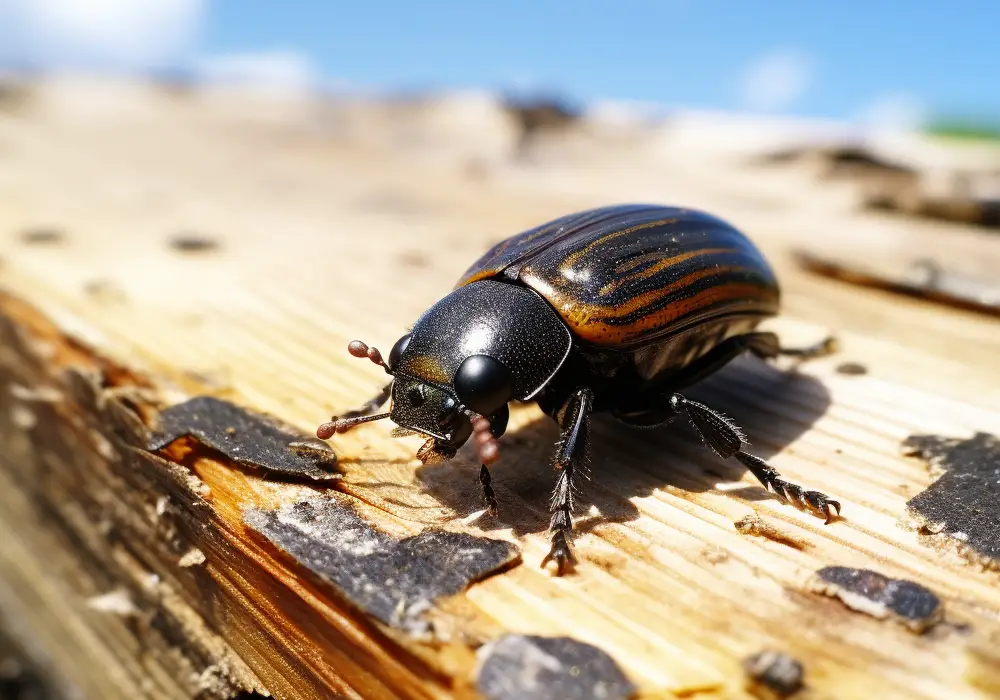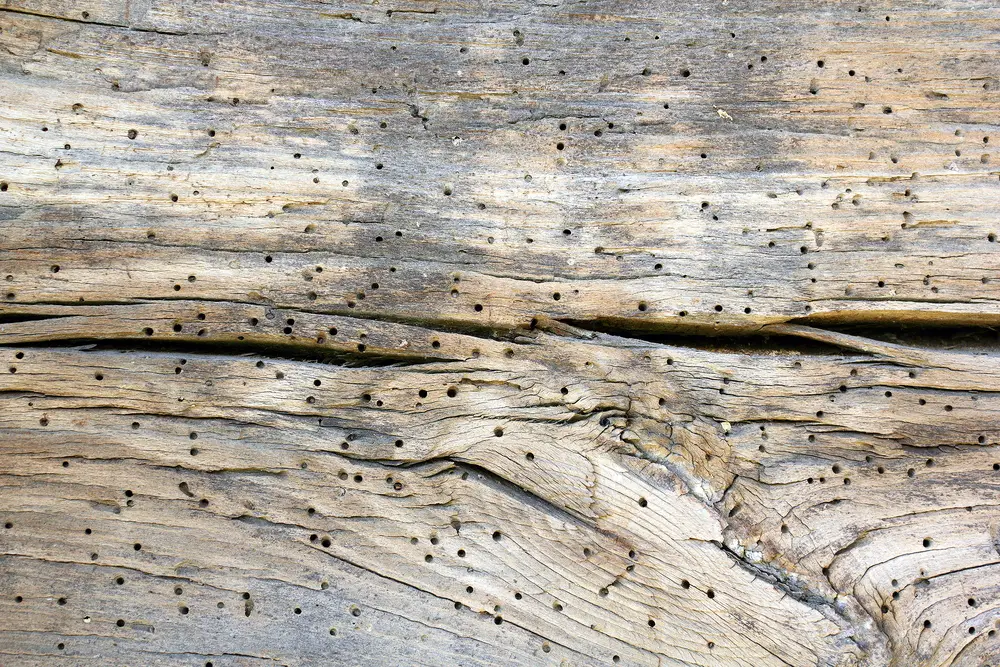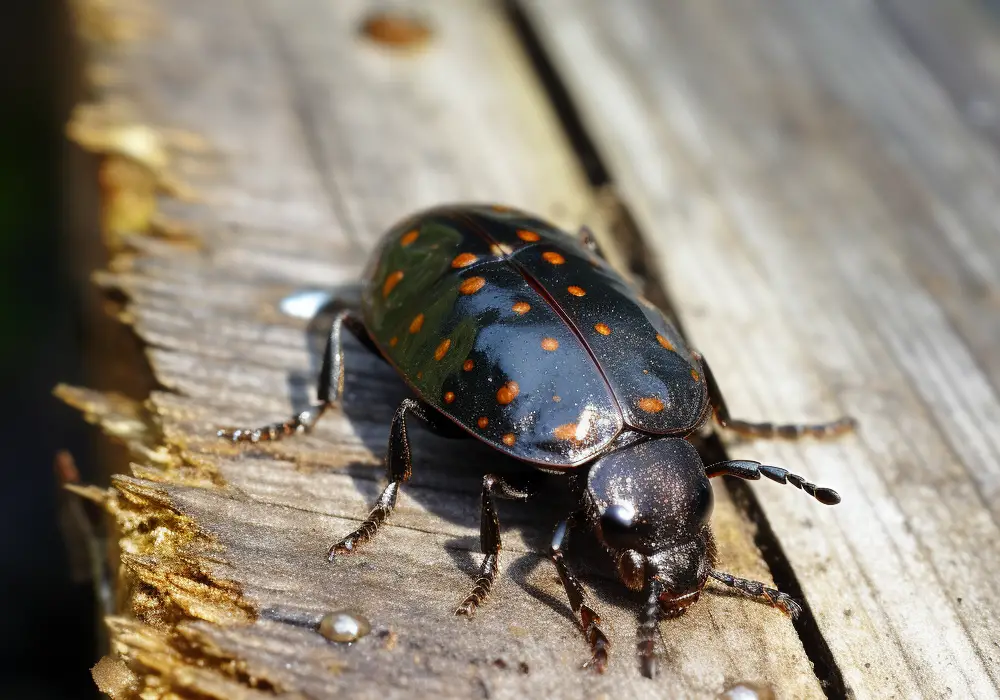Powderpost beetles are small, wood-destroying insects that can cause significant damage to homes and other wooden structures.
They are often considered one of the most destructive wood pests, and infestations can lead to costly repairs and even structural failure if not properly addressed. So, can powderpost beetles destroy a house?
Quick Answer:
Powderpost beetles can significantly damage a house if not addressed. Their larvae burrow into and feed on wood, weakening it over time. Especially attracted to hardwoods, they can infest structures, furniture, and flooring. Immediate action is necessary upon discovering an infestation.
In order to minimize the risk of powderpost beetles causing irreparable damage to a home, it is essential for homeowners to be vigilant and address any signs of infestation as soon as they are detected.
Regular inspections, prompt treatment, and preventative measures can go a long way toward protecting a home from these invasive pests.
Powderpost Beetles: An Overview
Powderpost beetles belong to the family Lyctidae and are known for their wood-destroying tendencies. These small insects can cause significant damage to both hardwood and softwood, ultimately posing a threat to the structural integrity of a house.
There are many species of powderpost beetles that have been found worldwide. Despite the varying species, their life cycles remain relatively similar. The life cycle consists of four stages: egg, larva, pupa, and adult.
The majority of the damage caused by these insects is done during their larval stage, as they bore through wood in search of nutrients.
The adult powderpost beetle lays eggs on the surface of wood, often in small cracks or crevices. Once the eggs hatch, the larvae begin to tunnel into the wood, feeding on the starches found within.
This is when the wood starts to weaken and is the primary cause for concern when dealing with a potential infestation. Larvae can remain within the wood for several months, up to a few years, depending on the species.
Once the larvae have completed their development, they enter the pupal stage, typically close to the surface of the wood. Here, they metamorphose into adults, emerging from the wood through small exit holes.
This is often the first visible sign of a powderpost beetle infestation, as the wood is left with numerous small holes accompanied by a powdery substance, hence their name.
Given the potential damage caused by these beetles, it is essential to take preventative measures to protect one’s home. This can include treating wood with borate-based products, controlling moisture levels, and ensuring proper ventilation in areas where wood is stored.
Additionally, using kiln-dried or pressure-treated wood can minimize the chances of powderpost beetle infestations.
Infestation and Detection
Powderpost beetles are known for their ability to infest and damage wooden structures in homes. An infestation typically begins when adult beetles lay eggs on or in the wood. These eggs then hatch into larvae, which are the primary culprits for causing damage to the wood.
The larvae burrow and feed on the wood, creating hollow tunnels or galleries as they chew through the wood’s interior. Over time, these galleries can weaken the wood and compromise the structural integrity of the house.
Detecting a powderpost beetle infestation can be challenging, as the adults are small and often go unnoticed. However, there are some telltale signs to look for. One of these signs is the presence of exit holes in the infested wood, which are created when adult beetles emerge from the wood after maturation.
These holes are usually about the size of a pinhead, so a close inspection of the wood is needed to locate them.
Another sign of infestation is the presence of fine, powdery frass that the larvae produce as they consume the wood. This frass can often be found around the exit holes or in visible cracks and crevices in the wood.
In addition to these indicators, it is crucial to inspect the overall condition of the wood, as heavily infested wood may exhibit signs of structural weakness or visible sagging.
To prevent and control powderpost beetle infestations, it is essential to take proactive measures. These include proper storage and drying of lumber, using treated or resistant wood species, and applying chemical treatments to at-risk areas.
Damage to Wood and Structures

Powderpost beetles can cause significant damage to wood and wooden structures, particularly hardwoods. These beetles have a preference for hardwood materials, which include popular choices such as oak, ash, and walnut.
When powderpost beetles infest wood, they dig tunnels to lay their eggs. As the larvae hatch and grow, they burrow further into the wood, creating more tunnels and gradually weakening the structure. Over time, this can lead to visible damage on the wood surface, showcasing an array of tiny, pinhead-sized holes.
Structural damage can occur as a result of a long-term infestation of powderpost beetles, causing issues with the overall integrity of wooden structures within a house. This damage may affect the framework, flooring, and even plywood used in the construction of the home.
Additionally, powderpost beetles can infest various wooden items within a house, such as paneling, molding, furniture, and picture frames. They have the potential to cause significant damage to these items, often gradually weakening them and potentially rendering them unusable.
To summarize, while powderpost beetles might not outright destroy a house in a short period, their presence can lead to extensive and costly damage to wood structures and hardwood items. It is essential to address an infestation promptly to minimize potential harm.
Signs of Infestation
Powderpost beetles can cause damage to wooden structures and materials. Recognizing the signs of their presence is essential for timely intervention. Here are some indicators of their infestation:
- Frass: This is a powdery residue that bears a resemblance to fine sawdust. It is actually excrement from the beetles and is a tell-tale sign of their presence. The frass can usually be found around the wood’s edges or on the surface where the beetles have infested.
- Round holes: These are the entry and exit points made by the beetles while boring into the wood. They are small, round, and typically have a diameter between 1/32 to 1/8 inch. The holes can be located on the surface or slightly below it, and they often appear in clusters.
- Sawdust: When the beetles tunnel through the wood, they leave behind tiny particles known as sawdust. This can often be found near the infested area or on the floor beneath it.
- Shot holes: Similar to the round holes, shot holes are also tiny entry and exit points made by powderpost beetles. However, these are even smaller and may be harder to notice. They can make the wood’s surface appear as if it has been peppered with tiny shot-like punctures.
- Odor: Although not widely known, some species of powderpost beetles, particularly the lyctid species, are known to produce a distinct, and often unpleasant, odor when they infest wood. This smell can be an indication of their presence, especially in cases of severe infestation.
Types of Wood Affected
Powderpost beetles can infest a variety of hardwoods and softwoods. However, they typically target certain types of wood, mainly those with high starch and moisture content.
Some common hardwoods that are susceptible to powderpost beetle infestations include oak, ash, walnut, hickory, mahogany, cherry, pecan, elm, and sycamore. These woods have a high starch content which attracts beetles and helps their larvae flourish.
On the other hand, softwoods are generally less prone to powderpost beetle infestation. These woods include pine, spruce, and fir. Nonetheless, beetles can still infest softwood timbers if the wood is not properly dried or if the moisture content is high.
Bamboo is another type of wood that can be affected by powderpost beetles. It is particularly vulnerable, largely because it has a naturally high moisture content and starch levels.
The moisture content in the wood plays a significant role in attracting powderpost beetles. Wood with higher moisture content (above 15%) provides a favorable environment for these beetles, as it supports both their growth and the growth of fungi on which they feed.
Prevention and Control Methods
Preventing a powderpost beetle infestation starts with proper moisture control. It’s important to maintain low moisture levels in the wood as these insects thrive in damp conditions.
Ensure proper ventilation in your home, and use dehumidifiers if necessary. Keep firewood away from your house and store it in a dry place as it could be a potential breeding ground for these wood-boring beetles.
When constructing a new home or adding wooden structures, consider using kiln-dried lumber. Kiln drying is a heating process that removes excess moisture from wood, making it less susceptible to powderpost beetle infestations.
This process also helps to kill any existing insects and their larvae.
Temperature treatment can be an effective method in controlling powderpost beetle infestations in smaller, infested items. Exposing the affected wood to extreme heat (e.g., 120°F or higher for several hours) or cold (e.g., 0°F or lower for several days) can kill the beetles and their larvae.
Another preventive measure is applying paint, varnish, or other sealants to exposed wood surfaces. These coatings serve as a barrier that prevents the beetles from laying eggs on the wood surface.
Regularly inspecting your furniture, flooring, and other wooden structures for signs of infestation is essential for early detection and intervention.
Insecticides and Treatment Options
Powderpost beetles can be a threat to wooden structures in a house, but there are effective measures to combat these pests. A variety of insecticides and treatment plans are available, offering tailored solutions to reduce or eliminate the infestation.
Pesticides are chemical substances used to kill or control pests like powderpost beetles. Among them are insecticides specifically designed to eradicate insects. One popular choice for treating powderpost beetle infestation is the use of borates.
Borates are salts of boric acid that have low toxicity for humans and pets but are highly effective in eliminating wood-boring insects. A well-known borate product is Tim-bor, which can be applied as dust, in liquid form, or as a foam.
When applied to the wood surface, borates not only kill adult beetles and their larvae but also create a protective barrier to deter future infestations.
Developing a proper treatment plan is vital to ensure success in addressing powderpost beetle infestations. A professional pest control expert can assess the situation, identify the source of the infestation, and recommend the most suitable course of action.
To be effective, treatment should include a thorough inspection of the infested area, identifying beetle entry points, and sealing them to prevent further infestation. In addition, ongoing monitoring and re-treatment may be necessary, as the insects may remain hidden in the wood for some time.
The cost of treatment depends on various factors, including the extent of the infestation, the size of the area affected, and the specific treatment options chosen. In some cases, using DIY insecticides may be a cost-effective way to address a minor infestation.
However, engaging the services of a professional exterminator may be necessary for severe cases. They will have access to specialized equipment and products, and their expertise can ensure effective treatment with minimal disruption to the household.
Documentation and Repair

Before starting the repair process, it is crucial to document the extent of the damage caused by powderpost beetles. This includes taking photographs, making notes, and assessing the affected areas for potential structural concerns.
By doing so, you’ll be able to develop a clear understanding of the work required to restore the property.
To initiate repairs, begin by removing any affected wood, such as trim or flooring. It is essential to dispose of infested materials safely to prevent the spread of the beetles.
Next, you will need to replace the damaged wood with new materials. Ensure that you use properly seasoned hardwoods, as they are less susceptible to powderpost beetle infestations.
During the repair process, consider using a dehumidifier in the affected areas to help reduce moisture levels. Powderpost beetles thrive in high-humidity environments, so maintaining low moisture levels can help prevent future infestations.
Additionally, using a freezer can be an effective method for small wooden objects infested with beetles. By freezing the items for several weeks, you can effectively kill any beetles and their larvae.
It is advisable to schedule routine inspections of the property after the repair work is complete. This will help identify any signs of new infestations promptly, enabling timely interventions to mitigate additional damage.
Professional pest control services can assist with these inspections and provide recommendations for preventative actions, including the application of appropriate insecticides as needed.
Lastly, it is important to have the necessary tools on hand for repairing the damage caused by powderpost beetles. A well-stocked toolbox should include equipment such as a hammer, nails, screws, a pry bar, and a saw for cutting and replacing damaged wood.
Additionally, safety gear, such as gloves, goggles, and a breathing mask, is crucial to protect from debris and allergens while working on the repairs.
Professional Assistance
When dealing with a powderpost beetle infestation, it’s crucial to seek the help of a pest control professional. These experts are equipped with the knowledge and tools necessary to effectively eliminate these destructive pests from your home.
A pest control professional will typically start by conducting a thorough inspection of your home to determine the extent of the infestation. This may involve checking for signs of damage, such as beetles’ boreholes and frass, as well as the presence of adult beetles and larvae.
A reliable inspector will also assess the humidity levels in your home, as powderpost beetles thrive in areas with high humidity.
It’s important to note that old house borer beetles, a close relative of powderpost beetles, can also cause significant damage to wood structures.
These beetles require a different treatment approach, making it crucial for the pest control professional to accurately identify the species responsible for the infestation.
Once the inspection is complete, the pest control professional will recommend a course of action tailored to your specific situation. This may include:
- Reducing humidity levels in your home by improving ventilation or using dehumidifiers.
- Treating infested wood with borate-based insecticides or other effective chemicals.
- Replacing heavily damaged wood structures to ensure the integrity of your home.
- Implementing preventive measures to avoid future infestations, such as sealing cracks and crevices where beetles can enter.
Companies like Orkin provide specialized services to tackle powderpost beetle infestations. With years of experience and a reputation for excellence, you can trust them to effectively handle any pest problem you may encounter.
Remember that timely intervention by a pest control professional is vital to protect your home from further damage and restore its structural integrity.
Building Materials and Supply
When constructing a home, it is crucial to consider the type of building materials used. This is especially important in the case of unfinished wood, which can be vulnerable to powderpost beetles.
A reliable supplier and manufacturer will ensure that the wood provided has been properly treated to minimize the risk associated with these pests.
One popular material for various construction purposes is bamboo. Touted for its sustainability and versatility, bamboo can also be an attractive option for exposed wood structures such as barns.
However, homeowners should be aware that, when not properly treated, bamboo can be susceptible to powderpost beetle infestations.
In case you’re planning to use exposed wood in your construction, it’s essential to invest in high-quality materials from a reputable supplier. Proper wood treatment, such as kiln drying, can significantly reduce the risk of powderpost beetle problems in the future.


